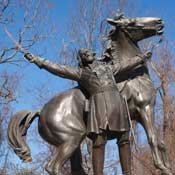As I pulled into Navy Circle in Vicksburg, my passengers, two female French engineering students, spoke politely and hesitantly in English. When the Mississippi River first came into view, their speech turned to a shrill, rapid-fire French. They scrambled for cameras and attempted to open the car doors while the car was still moving. All the while, their French was getting louder and more excitable.
Navy Circle, actually a semi-circle just off Washington Street, is complete with the ubiquitous cannon and signage marking the southwestern edge of the federal lines during the siege of Vicksburg. At several hundred feet above the Mississippi River, it provides an excellent viewpoint of the river and is one of my favorite places. Just north of the two bridges that cross the river in Vicksburg, Navy Circle is little visited and somewhat isolated.
At this point, the Mississippi River is about as big as it gets, draining some 41 percent of the United States and parts of two Canadian Provinces. A few miles downstream from here, about 30 percent of the river is diverted into the Atchafalaya River.
Vicksburg is the nexus of at least two titanic struggles and where you can get a feel for the passion and depth of the conflict of both. Here you can see evidence of a continuing struggle against nature in the temporary taming and confining of the Mississippi River and of the conflict that tore at the soul of this country and still reverberates 150 years after the Civil War.
I take all my out-of-town visitors to Vicksburg for a visit. Casinos are not on my list, nor is touring the Vicksburg battlefield until you are numb and confused about the entire event. Rather, it is a leisurely relaxing day with time to contemplate the enormity of the history of this town in just four stops.
From Navy Circle, the students and I headed north on Washington Street and turned left onto Clay and passed through the floodwall, which protects the city from any possible floodwaters, stopping on the steep ramp leading to the Yazoo River. Being hydrologists in training, the French students stuck their hands in the Yazoo River, then tasted it (that must be a French thing) and asked why it was that color, and was it always that brown. After a few minutes, I casually pointed back up the ramp to the floodwall. I loved watching their eyes as they first looked on in confusion trying to figure out what I was pointing at. Painted high up on the floodwall are the high-water marks from the various floods. It is fascinating to look up and think of the water that rose that high.
We then drove up Clay Street about five blocks and turned left onto Cherry Street. As the road narrows, you realize it is built on top of one of the many narrow and heavily wooded ridges that made Vicksburg such a formidable fortress. It's also a little known, little used and, for the most part, unmonitored entrance to the Vicksburg National Battlefield Park.
After entering the park, just downhill to the left and covered with a large outdoor tent, is the most amazing Civil War relic I have ever seen. The USS Cairo, one of the six city-class gunboats the union built during the Civil War to control the Mississippi, is here. In the tented half-light from overhead and with the background hum of humidifiers, you can enter its skeletal remains. It put the French students into a somber mood to think of the awesome power and ingenuity built into that gunboat for the purpose of death and destruction.
After years of neglect, the boat became impacted in mud, making the museum deliciously cool during a hot Mississippi day. It has clean bathrooms, and best of all it is small, but still packed with fascinating items that tell the story of the USS Cairo, of its sinking and its recovery some 100 years later.
Up until the 1880s, the Mississippi River approached Vicksburg from the northwest. Just before Vicksburg, the river curved to the northeast and then did a 180-degree bend on itself just in front of Vicksburg where the bluff hills meet the alluvial plain. This created a long stretch of land on the Louisiana side where the Mississippi River was just a few hundred meters in most directions. The Yazoo River joined the Mississippi well upstream of Vicksburg.
As any good hydrologist knows, however, rivers are fickle and go where they want to. The Mississippi River cut through the neck of the meander in the 1880s, leaving the Port of Vicksburg high and dry.
We headed out of the parking lot of the USS Cairo museum and up to the top of the hill to our last stop: the aptly named Fort Hill, which marks the northwestern limits of the Confederate lines. The hill is 200 feet high and dominates the landscape providing a beautiful vista in all directions. Now, the Yazoo River is on the western side, but during the Civil War the Mississippi River was there. Every time federal gunboats ran the Vicksburg batteries, they had to go by this hill.
The French students were fascinated with the story of how the Mississippi River decided to go further west, leaving the Port of Vicksburg high and dry, and how someone decided that to keep the port open they would change the course of the Yazoo River. They wanted to know how we could do such a thing. Why didn't we just move the port?
Later that night, hundreds of pictures went up on Facebook. The comments from their friends, although in French, were just as excited as they were. I knew then it was another successful tour of Vicksburg.



Comments
Use the comment form below to begin a discussion about this content.
comments powered by Disqus